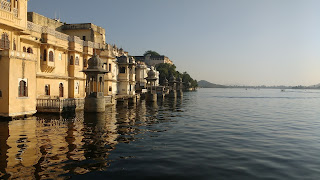Freelance
gun for hire, and going slow in Udaipur
Apologies for it being all quiet till
now
Life in Delhi has been as entertaining as ever, with the
added twists of bird flu, even more abysmal than usual air pollution and
demonetisation to deal with. How have I handled these three Indian horsemen of
the apocalypse? With my usual grace, flair, élan, sleights of hand etc…In all
seriousness, I appreciated getting out of Delhi recently for a weekend trip to
Udaipur in Rajasthan. Here’s what I got up to.
**************************************
Despite having lived in Delhi for over a year and a half all
told, I have seen precious little of neighbouring Rajasthan, aside from two
trips to Jaipur. The first time round I took in the sights of the Pink City
from a hospital bed while my family had fun exploring, while the second foray was
dedicated to attending Jaipur’s prestigious literature festival, allowing no
time to explore the city itself. So I was delighted when a weekend excursion to
Udaipur was proposed by friends; I felt I could start to fill a gaping hole in
my travel-map of North India.
 |
| View from Gangaur Ghat |
And so it was in Udaipur; a lunchtime stroll north of the City
Palace took us to one such place, a dhaba
(road-side canteen), perhaps slightly worn around the edges but welcoming enough,
where we enjoyed a Rajasthani classic: kachori, fried discs with a filling of lentils,
potato or onion and, of course, spices, accompanied by a rich tamarind chutney.
In the midday heat, a few kachori,
washed down with my poison of choice (chai, if you’re interested), were more than enough to sate my
appetite until evening. I came back again before I left and, over one final
round of kachori, managed to successfully
summon up enough of my meagre Hindi to convey my appreciation to the proprietor,
a trivial yet still satisfying achievement in my mind; while visiting the
Jagdish Temple the day before I had confidently informed a purveyor of
Udaipur’s famous miniature paintings that his work was delicious, but sadly not
for me.
**************************************************
Eager to take in some of the local culture however, I spent an
evening in the elegant eighteenth-century courtyard of Bagore-ki-Haveli, one of the city’s historic mansions, enjoying
performances from across the spectrum of traditional Rajasthani culture. The
show began with a dance by women from the Gujjar tribe, whose type of dance –
used for felicitous occasions – had gained recent viral fame thanks to a video
of two Gujjar women singing and dancing buoyantly in the incongruous setting of
the Delhi Metro. Despite the familiarity, it was still a wonderful experience
seeing it in person. With the Mewari sitting dance, it was difficult to decide
what should command one’s full attention: the fluid swaying back and forth of
the dancers, or their deftness in playing a pair of small cymbals
simultaneously.
Despite the artful guile of each performer, the most
enthusiastic applause of the evening was undoubtedly reserved for a woman who
slowly yet surely danced while balancing an eventual total of eleven water
gourds on her head, and briefly treading delicately on shards of glass. The
acclaim of the audience only increased when the master of ceremonies revealed
her age afterwards: 70 years!
**************************************************
Unlike my hard-working friends, I was lucky enough to have an
extra day in Udaipur before having to make tracks back to Delhi in the late
afternoon. As such, I decided to embrace my inner flâneur and take an unhurried walk through Udaipur’s neighbourhoods,
ostensibly to visit Sahelion ki Bari,
or the ‘Courtyard of the Maidens’. From what I had heard, its tranquil setting
of fountains and gardens seemed a fitting destination for a day of leisure.
That day was in fact meant to be a ‘day of rage’, or shutdown, in cities across
India as a protest by opposition parties against the recent demonetization measures.
In reality, as I stepped out of my hostel mid-morning, Udaipur seemed calm and
distinctly unperturbed – calm being a relative concept in India of course!
As I roamed, my eyes guiding me down alleyways, towards
well-maintained havelis and into the
thrum of markets, I was offered a road-side shave, a massage, a smoke, coconut
juice, spices…women adorned in the ubiquitous yet dazzling panoply of
Rajasthani colours diligently weaved reed baskets in the heat; tourists pawed
the leather bags hanging from shops, as the proprietors – very much in business
– looked eagerly on; locals offered a hasty prayer as they walked past
road-corner shrines. In wanton oblivion to the lofty words of the politicians in Delhi, life was assuredly carrying
on.
Turning around a bend in the road, I saw up ahead a rickshaw
clatter into another, a sharp exchange of words follow, and the inevitable audience
hastily assemble as motorbikes formed an increasingly lengthy queue of blazing
horns. A policeman, sporting a fine black beret, spiritedly yet
inconsequentially blew his whistle. An elderly man, his beard luridly streaked
with henna, walked insouciantly through the commotion, only briefly glancing
sideways before shuffling on.
In the end, I never reached my intended destination; I didn’t
really mind. In India, there is so much joy, amusement and profundity to be
found in the everyday, the mundane, if only you take a moment to pause and
watch. ‘People-watching’ is an inexact, somewhat clumsy term for this method of
travelling – as if one were going on a human safari. I’ve yet to think of a
better name for this fine art, but I’ll let you know someday.
On the train back, I thought about my wanderings that day, as
well as my immediate surroundings. For me, taking the train in India is like
entering a library…but that’s a thought for another time.














